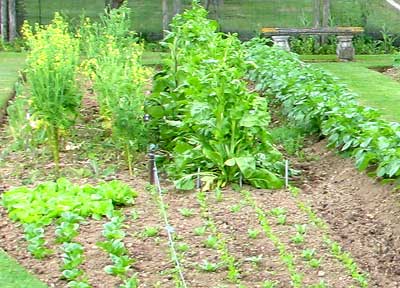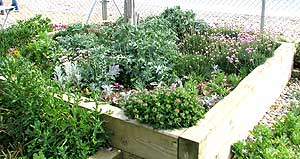Garden sheds: The importance of a garden shed
VEGETABLE PAGES
GROWING VEGETABLES IN RAISED BEDS
To make this as brief as possible may I just say that we had moved to our present address in the March of 2007, and as a very novice gardener I was blissfully unaware of the makeup of different soils, even though there is a well thumbed copy of The Organic Gardening Book in my garden shed.
 It was June 2007 and
we were off to France for a couple of weeks with our daughter. All the
veg were looking good even though the soil here is heavy clay, so having arranged with the
guy next door to keep an eye on my veg plot and water as necessary we
set off for France in good heart.
It was June 2007 and
we were off to France for a couple of weeks with our daughter. All the
veg were looking good even though the soil here is heavy clay, so having arranged with the
guy next door to keep an eye on my veg plot and water as necessary we
set off for France in good heart.
It wasn’t the best of holidays because we had some drizzle most days, but it wasn’t until we were given a several days’ old newspaper that we became aware of the terrible floods back here in the UK.
To cut a long story short, when we returned from hols all my veg were encased in something akin to concrete, and what had been nicely dug, fluffy soil, albeit of the clay variety, was now as solid as the proverbial rock.
 Carrots
which should have been growing vertically were now stunted and growing
sideways, and the other vegetables were affected in different ways.
Carrots
which should have been growing vertically were now stunted and growing
sideways, and the other vegetables were affected in different ways.
All that rain followed by a few days of hot sun had turned my beloved “veg plot” into a baked clay garden, and after all the hard work it had taken I nearly cried.
I mentioned my plight to another neighbour who said that because of the amount of really heavy clay soil in our area I may contemplate following his example of making some raised beds and filling them with new soil.
He showed me his vegetable garden which was made up of all raised beds and his carrots grew upwards rather than sideways - the route of least resistance which mine had followed.
That was enough for me so I went home, planned things out and set to work with a will.
 There
is always more than one way to do something and raised beds are no different
in that. My neighbour had made his from second hand railway sleepers which
he had pegged together at the ends to stop them falling apart. His were
roughly 8 feet long by 4’6” in width, and because he had dug out and disposed
of the soil inside they had a new soil depth approaching 15 inches.
There
is always more than one way to do something and raised beds are no different
in that. My neighbour had made his from second hand railway sleepers which
he had pegged together at the ends to stop them falling apart. His were
roughly 8 feet long by 4’6” in width, and because he had dug out and disposed
of the soil inside they had a new soil depth approaching 15 inches.
As it was painfully obvious that I would be unable to grow a crop that year I decided to make something a tad more long lasting, so it was off to the builders merchants to order a delivery of bricks.
Luckily I love building and have a cement mixer, so I dug out where the walls of the beds would be and made a concrete foundation whilst awaiting delivery of 200 red bricks.
To cut a long story short that raised bed was three bricks high and measured around 14 x 5 feet – a width which I was comfortable enough to lean over from either side.
I dug out the clay soil from within, riddled it all and mixed it with new, bought topsoil, sand and some manure I was lucky enough to come across at the right price.
The next growing season was a delight and the carrots grew as carrots should grow, onions were large and delicious, so of course this early success prompted me to make several more raised beds, and crops of virtually everything are so large that we have to give loads and loads of things away. No wonder the neighbours suddenly love us!
Article by Art Johnstone
www.logcabinhome.co.uk : Garden sheds and buildings
OTHER USEFUL ARTICLES ON GARDEN GROWER